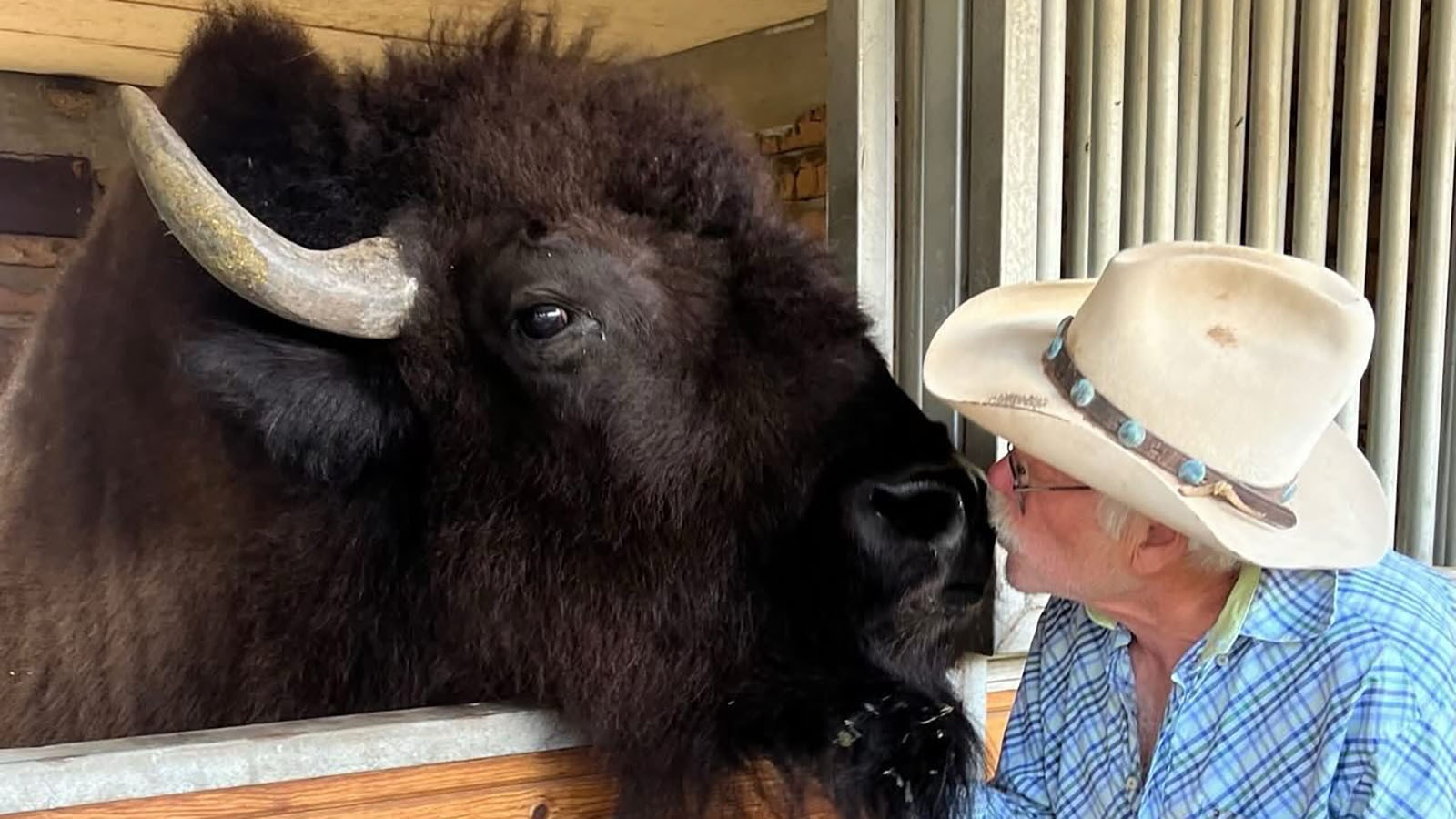FORT LARAMIE — The sun sank slowly in the sky to the west toward a dark and shadowed horizon.
People gathered slowly as the shadows lengthened, their words hushed and steps quiet and deliberate as they walked toward an 1883 stone structure at Fort Laramie that used to be known as the Commissary Storehouse.
At first, there was no hint to the casual passerby why so many people were gathering around the nondescript building, which these days serves as a visitor center.
The center is closed at this hour of the night. Closed, but not empty.
There are inhabitants who come out only at night. Creatures that have occupied the building more than 100 years.
The people waited as the sun dipped down to kiss the darkened horizon, before finally slipping entirely from view.
A lingering golden glow, with a hint of rose, made for a beautiful backdrop behind the historic building, and some people could be seen walking to their cars in the parking lot beyond.
About then is when the building’s mysterious inhabitants suddenly made themselves known, with a raspy, unintelligible chattering that sounds alien. With it, whispers from human voices rose as well, a kind of seance of nature.
Miniature Thunderbirds On The Wing
Ellen Whittle, leading the group, lifted her night-vision goggles up the instant she heard the sound, knowing exactly what it signaled.
A brown bat, heavy and pregnant, was about to come slipping silently from the roof, out into a soft and welcoming summer’s eve in search of her evening meal.
Pregnant bats do not have litters of offspring. Like people, they typically have just one baby at a time, although there are sometimes twins.
No one knows for sure how long the bats of Fort Laramie have been returning to this particular summer roost. They come back every year for as far back as anyone can remember, as soon as the air has warmed enough for insects to flit about.
Whittle sometimes imagines the conversations that must be taking place among the chattering bats right before they emerge into the night sky.
“I’m not going out first,” one might be saying. “It’s your turn to go out first.”
“Fine, all right. I’ll go out first — this time. But next time it’s your turn!”
Right before each bat comes out into the night, their vocalizations suddenly stop. There’s a silent pause and then out they come with a dramatic entrance, gracefully, but silently, dipping and swooping like a miniature Thunderbird — every bit as thrilling as the military planes that perform at Cheyenne Frontier Days every year.
The lonely exit, one bat by one bat by one bat, was a surprise to first-time viewers, including this reporter. There was no huge, hungry horde of bats dramatically whooshing out all at once, like in the movies.
That’s just one of many myths about Wyoming’s bats that Whittle is happy to dispel.
“These bats typically do come out just a few at a time to avoid predation,” she told Cowboy State Daily.
Bats are predators themselves, but, in the grand universe of predators, they are teeny and tiny. Discretion is the better part of their valor.
Whittle And Wild Places
Whittle is an adventurous researcher who has studied endangered species on the north slopes of Alaska, as well as grizzly bears in Montana and prairie chickens in Kansas.
Right now, she’s the bat project manager for the Wyoming Natural Diversity Database. She manages several bat research projects across Wyoming, including the site at Fort Laramie.
The Fort is a relatively new site for bat studies in Wyoming.
“This is a rare place for us to have a really large collection of these bats together in one colony,” she said. “I really can’t think of any other place like it. Everywhere else that we are studying, we pretty much have to set up nets on the landscape and then just catch what we can catch — bats that might be just passing through, bats that might not be residents.”
That makes Fort Laramie an important new site that offers rich opportunities for future studies, including the little-known social behavior of bats living together in a maternity colony.
“We vaguely knew that there were bats at Fort Laramie, and the park rangers were aware they were roosting in the buildings,” Whittle said. “But figuring out exactly where they’re coming from requires sitting patiently and watching at night.”
Last year, Whittle and a crew of researchers came to the Fort to do exactly that. That’s when the size and special nature of the colony became clear.
“We’re trained to spot bats coming out of places,” she said. “So, we recognized that what we were seeing was a colony roost.”
Further study revealed that it was a maternity colony as well, a sheltered place where female bats gather to not only give birth but raise their young.
Whittle thinks the location has so many bats because of all the water around the area. That makes plenty of insects to feed hungry momma bats who are about to have babies.
White Nose Syndrome
One thing that’s been taking up a lot of Whittle’s time lately is a disease called white nose syndrome.
Wyoming’s bats have no prior immunity to the disease, which is a European import. That’s made them especially vulnerable. Some colonies have lost as many as 90% of their members to the disease.
It’s not known how many of the Fort Laramie bats have died.
“We can pretty well assume that there’s been mortality the last couple of years (at Fort Laramie),” she said. “But we don’t know exactly how much. We’ve basically seen 100% contamination with the fungus when we’ve gone to swab all of the bats.”
The only good news so far, she added, is that the rate of contamination does seem to have decreased a tiny amount.
“That’s kind of exciting to see that the disease rate might actually be slowing or even going down a little bit maybe,” she said. “But one year is a little too early to say for sure what the pattern is.”
Living With Bats
The big brown bats aren’t the only bats who occupy Fort Laramie in the summer. There are also little brown bats, who live in nearby bat condos, which look a bit like tiny treehouses on stilts.
The condos were erected in the 1990s, in hopes of luring the big brown bats out of the Fort Laramie buildings, according to Fred MacVaugh, cultural resources program manager for Fort Laramie.
“You couldn’t seal up the buildings to keep the bats out without damaging the historic integrity of the buildings, which is not something we want to do,” he said. “We’re here as a park unit to protect and preserve these historic structures and to maintain their architectural integrity. So, we live with the bats, even though they do get a bit sticky on occasion.”
By “sticky,” MacVaugh means he and his coworkers can sometimes smell bat guano in the buildings where they work. On occasion, it’s also necessary to clean and add a fresh coat of paint, to get rid of staining.
Bats have been at the fort probably since the first building went up, MacVaugh added.
“They were here historically, even when the military was actively using Fort Laramie,” he said. “Our chief of interpretation says there’s at least mention of the bats in the old surgeon military records. So, the military people here during that time knew that bats were around. And I wouldn’t be surprised if bats weren’t also roosting in the buildings, even back then.”
The little brown bats, who moved into the bat condos are doing worse than the big brown bats, Whittle said, and are part of a vaccine trial. Data on that should be coming out soon.
Bat Myths And Mysteries
There’s a lot that nobody knows about the bats of Fort Laramie, including where the colonies go when they hibernate in the winter.
It’s just one of the many bat mysteries that researchers are trying to uncover when it comes to the state’s 18 known species of bats.
Bats are a little like black cats, in that there are many myths and misinformation circulating around them. Whittle has heard them all at one time or another.
Bats are blind, so that’s why they bump into humans and often get tangled in hair.
While it’s true bats can use echolocation, Whittle said that’s primarily a hunting skill they use to locate insects while they’re on the wing. Bats, otherwise, have two perfectly good pairs of eyes, and they can see just fine with them.
As far as bumping into people goes, that does happen, infrequently. Much for the same reason people bump into things.
“They make mistakes sometimes,” Whittle said, shrugging. “They can sometimes be clumsy, just like people.”
Bats are bloodthirsty flying mice, who carry many diseases.
While it is true that some bats, just like any mammal, can carry rabies, fewer than 1% of bats actually have the disease.
Those that do have rabies are likely to exhibit weird behavior like being active during the day, having trouble flying, being found in unusual locations, such as inside a home. Disorientation, aggression, and staring are also symptoms, as is losing their fear of humans.
Any potential contact with bat saliva — including simply waking up in a room with a bat — or even the tiniest bite or scratch should be reported to a physician or public health professional, who will determine if there’s need for further medical evaluation.
Bats are vampires who can drink human blood and attack people.
That’s one that Whittle can’t help but laugh at just a little bit.
“In Wyoming, we pretty much have entirely insect-eating bats,” she said. “And they don’t have any interest in people at all. When people say that they attack people that’s interesting, because they are very much human averse. They really don’t want anything to do with people at all.”
In fact, even when Whittle has grabbed a bat out of the sky for a study — rude — what she has observed is that the bat in her gloved hand is still not interested in attacking her at all.
“They’re actually pretty gentle animals,” she said. “They are hunters, but they’re hunting insects, and they don’t want anything to do with people.”
Renée Jean can be reached at renee@cowboystatedaily.com.















